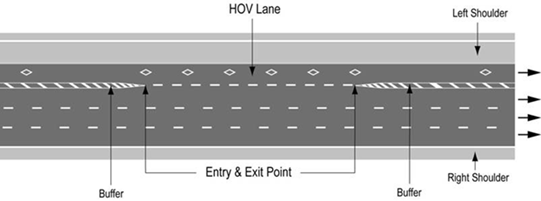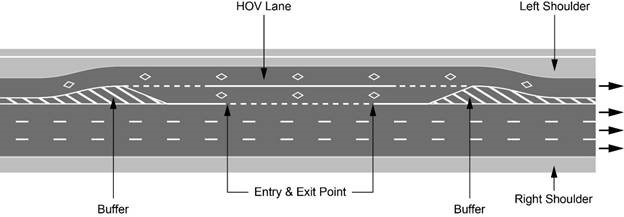Ontario installs newly designed HOV lanes and here are the rules
 These are the new HOV lanes on Highway 400. Would you know what to do here?
These are the new HOV lanes on Highway 400. Would you know what to do here?
Ontario has installed HOV lanes on a major highway that have a new design and different set of rules that might be confusing for some drivers seeing them for the first time.
The Ministry of Transportation said the newly installed HOV lanes on Highway 400 in Vaughan were opened this week.
Here's how they work.
Existing HOV traffic lanes in Ontario allow for vehicles to enter or exit by moving across a dashed lane marking located along the HOV lane.
The driver merges out of the HOV lane and straight back into the regular flow of traffic.

The new design on Highway 400 uses a dedicated transfer lane for motorists to enter and exit the HOV lane.
Motorists who want to leave the HOV lane must merge into the transfer lane before going back into the regular traffic lanes.

Why is the government doing this?
The Ministry of Transportation told CTV News Toronto the existing HOV lanes provides “satisfactory guidance” to drivers who are entering and exiting during most traffic conditions.
But in some situations, the government says there can be operational and safety concerns when HOV lane traffic merges back into the typically slower moving general-lane traffic.
The newly designed lanes give motorists a chance to slow down to the speed of regular traffic before merging back.
Highway 400 is currently the only place where these lanes exist and no changes have been made on Highway 404, Highway 403, Highway 427, Highway 410, Highway 417 and the QEW.
CTVNews.ca Top Stories

'She will not be missed': Trump on Freeland's departure from cabinet
As Canadians watched a day of considerable political turmoil for Prime Minister Justin Trudeau and his government given the sudden departure of Chrystia Freeland on Monday, it appears that U.S. president-elect Donald Trump was also watching it unfold.
BREAKING Canadian government to make border security announcement today: sources
The federal government will make an announcement on new border security measures today, CTV News has learned.
Canada's inflation rate down a tick to 1.9% in November
Inflation edged down slightly to 1.9 per cent in November as price growth continued to stabilize in Canada.
The Canada Post strike is over, but it will take time to get back to normal, says spokesperson
Canada Post workers are back on the job after a gruelling four-week strike that halted deliveries across the county, but it could take time before operations are back to normal.
Transit riders work together to rescue scared cat from underneath TTC streetcar
A group of TTC riders banded together to rescue a woman's cat from underneath a streetcar in downtown Toronto, saving one of its nine lives.
Trudeau considering his options as leader after Freeland quits cabinet, sources say
Chrystia Freeland, Canada's finance minister, said in an explosive letter published Monday morning that she will quit cabinet. Here's what happened on Monday, Dec. 16.
Teacher and a teenage student killed in a shooting at a Christian school in Wisconsin
A 15-year-old student killed a teacher and another teenager with a handgun Monday at a Christian school in Wisconsin, terrifying classmates including a second grader who made the 911 call that sent dozens of police officers rushing to the small school just a week before its Christmas break.
A bomb killed a Russian general in Moscow. A Ukrainian official says secret service was behind it
A senior Russian general was killed Tuesday by a bomb hidden in a scooter outside his apartment building in Moscow, a day after Ukraine’s security service leveled criminal charges against him. A Ukrainian official said the service carried out the attack.
Tom Cruise gets a top U.S navy honour for boosting the military with his screen roles
Tom Cruise was awarded the U.S. navy's top civilian honour on Tuesday for 'outstanding contributions to the Navy and the Marine Corps' with 'Top Gun' and other films.
































